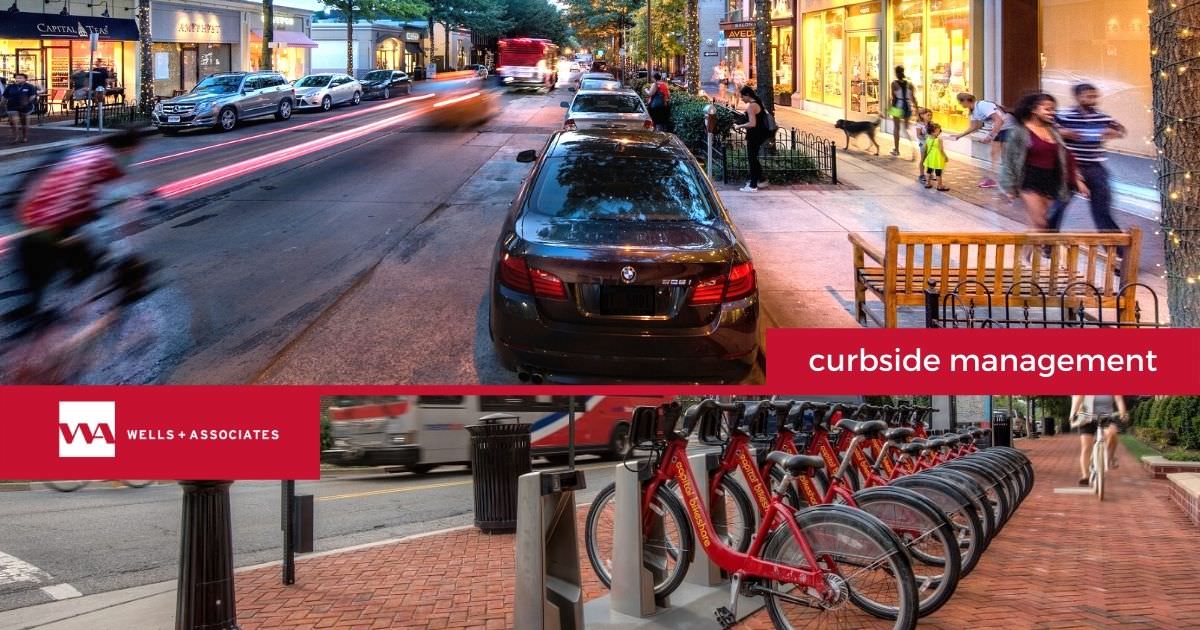The rapid evolution of urban transportation has made the roadway space adjacent to the curb one of the most valuable assets in any city. The advent of app-based travel, significant increases in parcel deliveries and food deliveries, the introduction of streeteries and expansion of parklets during the pandemic, and traditional uses such as parking and commercial delivery zones make the curbside a highly sought-after commodity.
At Wells + Associates, our traffic engineers and transportation planners relish the challenge of helping communities and developers redefine curbside areas to accommodate this multitude of users. There are many strategies to get the most out of curbside areas. These strategies contribute to the sustainability of urban and urbanizing areas.
Traditional Use of Curbsides
Curbsides traditionally have been used for vehicle parking, loading zones, and bus stops. While these traditional uses are still important components of curbside use, they do not reflect the changing landscape of transportation and mobility options.
Curbsides: Increasingly Defined by More Uses
The fact is that curbside space can benefit a wide variety of road users. Our role is to help unlock the potential of existing and future curbsides, taking into account the potential use of this space by:
- Parcel and food deliveries
- Passenger pick-ups and drop-offs
- Valet operations
- Green stormwater infrastructure
- Small public spaces
- Streeteries
- Vendors
- Paratransit
- Transit infrastructure
- Safety enhancements (such as bulb outs or curb extensions)
- Micromobility (lightweight vehicles such as scooters and bicycles)
- Electric vehicle charging stations
Managing curbsides for these uses can come in many forms. Using the curbside management toolbox, we analyze uses and traffic patterns to organize curbsides along three possible “flex zones”:
- Using the same space for multiple functions
- Allocating different functions by time of day
- Dividing the block into different zones, with each zone accommodating a different function
By gaining an understanding of the city’s priorities coupled with the needs of nearby businesses, residents, and other stakeholders, we can develop curbside management plans that help prioritize the curb space to ensure all users are accommodated and to promote safety and mobility.
Curbsides: One Size Does Not Fit All
Curbside use also varies by the function of its adjoining land use, such as residential, commercial, mixed-use, and industrial. Each land use starts with transportation plan priorities. However, subsequent priorities then vary based on type of land use as illustrated in the graphic below from ITE’s Curbside Management Practitioner’s Guide.
Curbside Use Priorities by Context:
| Priority | Residential | Commercial & Mixed Use | Industrial | ||
|---|---|---|---|---|---|
| 1 | Support for Modal Plan Priorities | ||||
| 2 | Access for People | Access for Commerce | |||
| 3 | Access for Commerce | Access for People | |||
| 4 | Greening | Activation | Storage | ||
| 5 | Storage | Greening | Activation | ||
| 6 | Activation | Storage | Greening | ||
Local jurisdictions are increasingly concerned not only with improving curbside management but studying and implementing policies and guidelines that help curbside areas serve a wider range of uses.
In our work, we first inventory existing conditions. Once the existing conditions are understood, we identify anticipated activity associated with nearby land uses and recommend appropriate curbside treatments to accommodate those uses. We then work with the governing jurisdiction and other stakeholders to refine and implement the proposed curbside management strategy.

